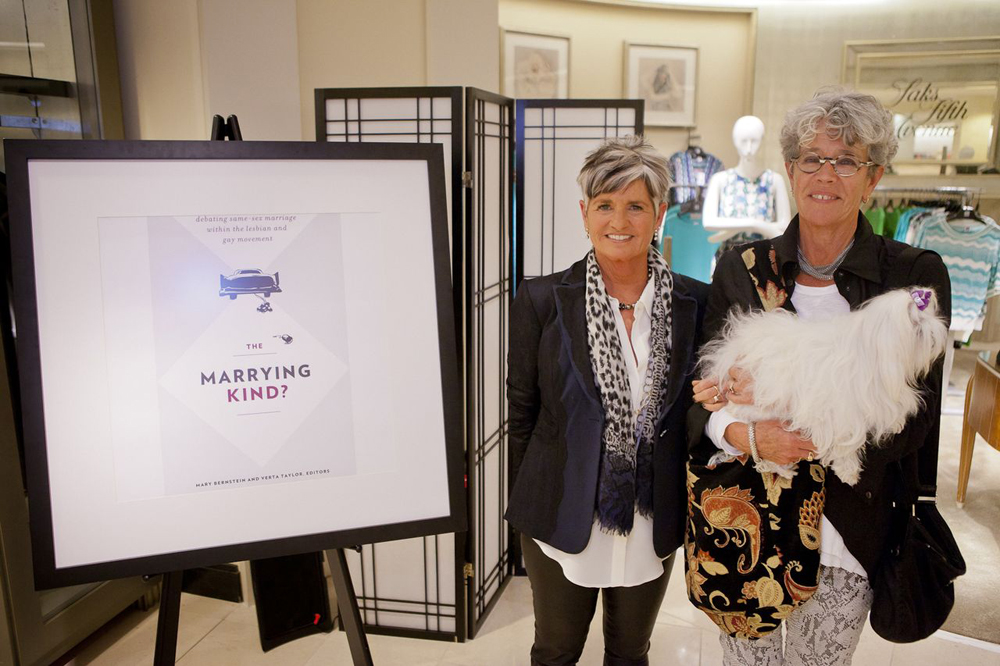
Few issues in American society have provoked such polarized –– and heated –– responses as same-sex marriage. What may come as a surprise, however, is how polarizing the right to marry has been within the gay and lesbian community.
In her new book, "The Marrying Kind? Debating Same-Sex Marriage within the Lesbian and Gay Movement," Verta Taylor, a professor of sociology at UC Santa Barbara, examines arguments within the lesbian, gay, bisexual, and transgender (LGBT) movement in support of –– and in opposition to –– same sex marriage, and how they have affected marriage equality campaigns. Analyzing the rhetoric, strategies, and makeup of the LGBT organizations pushing for same-sex marriage, Taylor and her co-editor, Mary Bernstein of the University of Connecticut, address the dire predictions of some LGBT commentators that same-sex marriage will spell the end of queer identity and community.
"I began to study the movement for marriage equality in California in 2004, the year that over 4,000 same-sex couples traveled from across the United States to marry on the steps of City Hall in San Francisco to protest our exclusion from marriage and to demand that our relationships and marriages be recognized," said Taylor. "Also, I thought that writing this book would give us an opportunity to examine the debate over marriage that was taking place inside the LGBT movement, and to understand how it was affecting the success and failure of the campaign for same-sex marriage in the states."
According to Taylor, marriage has not always been a goal of the LGBT movement. It first made it onto the agenda in 1987 at the third national March on Washington for Lesbian and Gay Rights. That march sparked a movement to achieve domestic partnership laws and policies designed to provide some recognition to same-sex couples by employers and local and state governments. The result was a limited set of benefits granted to same-sex partners.
"But regardless of whether or not it was considered desirable, LGBT activists believed at the time that same-sex marriage was simply not a political possibility," Taylor continued. "Such recognition was almost unimaginable, especially for lesbians and gays who had lived through the era of the closet."
After the passage of Proposition 8, which banned same-sex marriage in California, the LGBT movement both in the state and nationally began to divert its attention and resources to the campaign for marriage equality. However, debates launched by queer activists and queer theorists addressed whether or not the movement should focus so much of its efforts on a goal that moderates believed was an impossibility, and radicals considered completely out of step with the "radical agenda" of gay liberationists and queer theorists.
"The essays in this volume reflect on queer activists' opposition to marriage by addressing their predictions that the legalization of same-sex marriage will encourage LGBT couples and families to mimic heterosexual families structured around male dominance," Taylor said. Queer activists argue that this will bring about the end of a distinctive queer identity and community.
"We present clear evidence that these predictions simply haven't panned out," Taylor continued. "For example, while same-sex marriage may encourage relationships that replicate conventional marriage, they depart in important ways from traditional male-dominated marital arrangements that have been so repugnant to gay liberationists and queer activists."
In a study of legally married gay couples from Canada, where same-sex marriage has been legal long enough to assess its outcomes, Adam Isaiah Green, an associate professor of sociology at the University of Toronto and a contributor to the volume, reports that same-sex marital relationships tend to be more egalitarian with decision-making, the division of household labor, control of finances, and even questions of sexual fidelity negotiated between spouses, rather than based on traditional gender norms of marital monogamy.
"Although marriage equality has been advocated by national LGBT organizations for well over a decade, there is a difference between supporting the principle of marriage equality and actually choosing to be married," noted Taylor. "Two essays in our book reveal the ambivalence toward marriage that still exists among lesbians and gay men."
† Top image: Verta Taylor, left, and Leila Rupp, her partner of 35 years, at a book signing sponsored by Saks Fifth Avenue and Chaucer's Bookstore in Santa Barbara. Taylor and Rupp were married at the Santa Barbara County Courthouse in 2008.
Related Links



